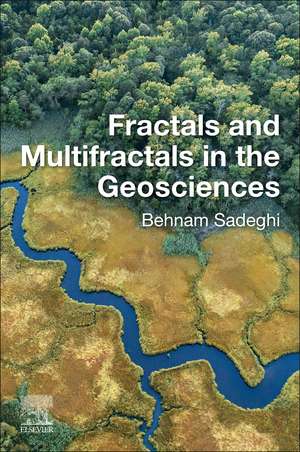Fractals and Multifractals in the Geosciences
Autor Behnam Sadeghien Limba Engleză Paperback – 21 mai 2024
Fractals and Multifractals in the Geosciences will be invaluable for mathematical geoscientists, geostatisticians, exploration, applied, urban and environmental geochemists, computational geoscientists, data scientists, and GIS professionals who need to better understand fractal geometry, along with its theory and applications in geochemical anomaly classification to generate maps that are helpful for decision-making for follow-up sampling and explorations.
- Provides a comprehensive overview of the use of fractal and multifractal modeling methods, with a detailed assessment of uncertainty quantification in samples and classified models
- Specifically includes novel multifractal models, as well as uncertainty quantification and decision-making methods for use in geosciences and especially geochemistry
- Includes case studies showing the application of the fractal and multifractal methods detailed in the book
Preț: 777.61 lei
Preț vechi: 854.51 lei
-9% Nou
Puncte Express: 1166
Preț estimativ în valută:
148.79€ • 162.13$ • 125.38£
148.79€ • 162.13$ • 125.38£
Carte tipărită la comandă
Livrare economică 16-30 aprilie
Preluare comenzi: 021 569.72.76
Specificații
ISBN-13: 9780323908979
ISBN-10: 0323908977
Pagini: 302
Dimensiuni: 152 x 229 mm
Greutate: 0.41 kg
Editura: ELSEVIER SCIENCE
ISBN-10: 0323908977
Pagini: 302
Dimensiuni: 152 x 229 mm
Greutate: 0.41 kg
Editura: ELSEVIER SCIENCE
Cuprins
1. The theory of fractal geometry
2. Introduction: characterising and mapping anomalies
3. Geochemical datasets
4. Novel multifractal classification models
5. Effectiveness and uncertainty in geochemical anomaly classification models
6. Spatial uncertainty in categorising geological data
7. General discussion and conclusions
2. Introduction: characterising and mapping anomalies
3. Geochemical datasets
4. Novel multifractal classification models
5. Effectiveness and uncertainty in geochemical anomaly classification models
6. Spatial uncertainty in categorising geological data
7. General discussion and conclusions
